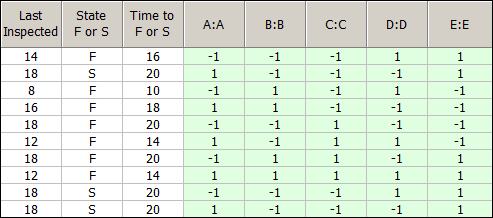

| Related Topics: | ||
After you build a factorial reliability design, the Data tab will include a test plan with Life Data columns for entering response data. The first ten rows of an example plan with interval data is shown next.

Each row represents a test run. The green columns display the factor level combinations to be used in each run, and the last column records the response values measured for each run. For example, first row shows that the factors levels for the first run were set to low, low, low, high and high for each factor. At this run, the test unit failed was found to not be failed at time = 14 and was found failed at time = 16.
All of the available columns for factorial reliability designs are described in more detail below. To hide/show columns, use the Visible Columns window.
Standard Order displays the basic order of runs, as specified in the design type, without randomization. This pattern is provided as a reference (e.g., textbook examples often use the standard order).
Tip: If you need to use a non-randomized order in an actual experiment, you can sort the design by clicking a cell in the column you wish to sort by and choosing Sheet > Sheet Actions > Sort > [Order]. For example, if changing levels in a randomized experiment would be too expensive, you can sort the design table by factor levels.
Run Order displays the randomized order generated by the software. By conducting experiments using a randomized order, you can reduce the effect of factors not being investigated.
Point Type Column indicates what kind of point the run is. 0 indicates that the run is a center point. 1 is used for all other points.
Block Value displays the block to which the run belongs. If the design is not blocked, all rows will display the same default value.
Life Data Columns are present only for reliability DOE. The columns that are available depend on the type of life data specified when the design was created. These columns take the place of the response column(s) in a standard design, and are used to calculate the underlying response for the design, which is considered to be time.
Time Failed Column allows you to enter the failure time for each unit. This column is available only for times-to-failure data with no censoring (complete data).
State F or S Column allows you to specify whether the unit is failed (F) or suspended (S). This column is available only for data with right censoring.
Time to F or S Column allows you to enter the failure time for the unit or, in the case of suspended units, the time at which the unit was removed from the test while still operating. Note that you can enter a negative number in this column and it will automatically be marked as a suspension in the State F or S column. This column is available only for data with right censoring.
Last Inspected Column allows you to enter the last time the unit was inspected prior to the time it failed. This column is available only for data with interval and/or left censoring.
State End Time Column allows you to enter the time at which the unit’s state was discovered (i.e., the first inspection time after the unit’s failure). This column is available only for data with interval and/or left censoring and without right censoring.
To change the type of life data used in the experiment, use the Alter Data Type window.
Factor Columns display the settings used for each factor in the run. By default, these columns are titled using the format "X: Factor Name," where X is the abbreviated name. If you have defined the units for the factor, that will also be displayed in the column header. Factor columns are shown in green by default.
Factor levels can be displayed as the actual values assigned in the factor properties or as coded values. When you use coded values for two level factorial or Plackett-Burman designs, the low level will be displayed as -1 and the high level will be displayed as 1. When you use coded values for general full factorial or Taguchi OA factorial designs, the lowest level will be displayed as 1, the next level as 2, and so on.To switch between coded and actual values, choose Data > Display > [Value Type].
Response Standard Deviation Columns are available only when you select to perform variability analysis. These columns show the standard deviation of the selected response at each factor level combination. (Asterisks indicate that the standard deviation was shown in a previous row.)
Comments allows you to enter notes or other text for each run. This information is not used in any calculations.
© 1992-2015. ReliaSoft Corporation. ALL RIGHTS RESERVED.